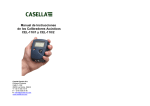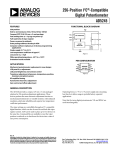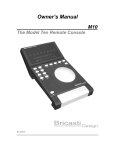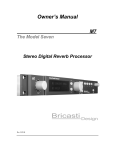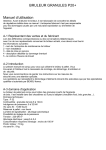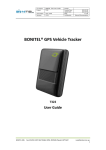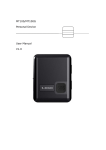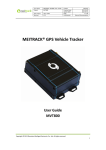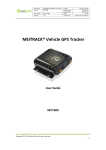Download User Guide - Bricasti Design
Transcript
M1 Dual Mono D/A Converter USB User Guide V1.04 release Conformity EMC / EMI This equipment has been tested and found to comply with the limits for a Class B digital device, pursuant to part 15 of the FCC rules. These limits are designed to provide reasonable protection against harmful interference in residential installations. Canadian Customers This Class B digital apparatus complies with Canadian ICES-003. Cet appareil numerous de la classe B est conforme a la norme NMB-003 du Canada. Certificate Of Conformity Bricasti Design, 123 Fells Ave., Medford MA, USA, hereby declares on its own responsibility the following products: M1 –Dual Channel A/D Converter -that is covered by this certificate and marked with the CE-label conforms to the following standards: EN 60065 Safety requirements for mains operated electronic and related apparatus for household and general use EN 55103-1 Product family standard for audio, video, audiovisual and entertainment lighting control apparatus for professional use. Part 1: Emission EN 55103-2 Product family standard for audio, video, audiovisual and entertainment lighting control apparatus for professional use. Part 2: Immunity With reference to the regulations in the following directives: 73/23/EEC, 89/336/EEC January 2012 Brian S Zolner President i Introduction This is a preliminary edition of the M1 user guide covering theory of design and setup and use. In the future you can always find the latest version available at our web site www.bricasti.com. Congratulations on the purchase of your new M1 Dual Mono Digital to Analog Converter. We at Bricasti Design have set out to design the world’s best digital processors and to offer the finest products made for the professional and consumer audio markets. Product Overview The M1digtal to analog converter is a dual mono design; there are 2 completely isolated channels, a left and right, each with its own dedicated linear power supply, D/A converter, DDS clocking, and analog circuitry. This design insures that analog cross talk is virtually non existent, that the necessary power requirements for each channel are well met and isolated from each other and the digital processing is isolated, having its own power supply. With our twin DAC design, the dynamic range for each channel is optimized by using the stereo ADI 1955 D/A converter in a mono configuration, plus clocking is for each channel done directly at each DAC with a technique called DDS (direct digital synthesis) which takes clock induced jitter to immeasurable levels. Build Quality The M1 is robustly constructed of milled and CNC machined aluminum sections. There is no typical bent metal chassis and top cover found on most products. All sections of the construction, the front and rear panels, the sides and even the bottom and top plates start out as solid blocks of aluminum which are precision machined to shape, with exact tolerances for a perfect fit. These parts are then anodized and the text and markings and are laser etched for a clean and enduring look. The Sound The intention if the M1 is to provide a state of the art, Digital to Analog converter, utilizing the best designs and materials that can be found today. The D/A converter is a very critical part of the digital audio chain, after all you have to convert it to analog to hear it, and we feel this should be a true as possible in its reconstruction of the original signal. The sound of the M1 is intended to be transparent and revealing, and fully dynamic. This in part is made possible by the lowering the jitter to extremely low levels, providing a pure digital signal chain with no SRCs ( sample rate converters) or digital volume controllers, superior digital filter design, coupled to a fast transparent analog signal path with a discreet analog output section and plenty of good clean linear power for optimum analog performance. Many hours of listening were done to tune the M1 to an exacting sound, with all types of music, and with extensive testing done in the studio and in the home. We hope you find the M1 to be pleasing and enjoyable to hear and use in the home, or as a precision tool for high level reference monitoring for the professional. ii Unpacking and Inspection After unpacking the M1 save all packing materials in the event you ever need to ship the unit. Thoroughly inspect the M1 and packing materials for any signs of damage in shipment. Report any damage to the carrier at once. Precautions The Bricasti Design M1 is a rugged device with extensive electrical protection. However, reasonable precautions applicable to any piece of audio equipment should be observed. Always use the correct AC line voltage as set by the manufacturer. Refer to the power requirements section of the manual and adhere to any power indications on the rear or bottom of the chassis . Using the incorrect AC line voltage can cause damage to your M1, so please check this carefully before applying power. Do not install the M1 in an unventilated rack or directly above any heat-producing equipment like power amps, tube preamps etc. Maximum ambient operating temperature is 40 C. Exceeding the maximum ambient temperature may cause the M1 to enter thermal shutdown and stop processing sound as a safety precaution, and may cause damage to the internal processors and components. To prevent fire or shock hazard, do not expose the M1 to rain or moisture. Notices In the interest of continued product development, Bricasti Design reserves the right to make improvements to this manual and the product it describes at any time and without notice. Copyright 2011 Bricasti Design LTD 123 Fells Ave Medford MA 01255 USA 781 306 0420 bricasti.com All Rights Reserved This publication is protected by copyright and all rights are reserved. 1 Important Safety Instructions: Notice! Warning! Read these instructions. Keep these instructions. Heed all warnings. Follow these instructions. Do not use this apparatus near water. Clean only with dry cloth. Do not block ventilation openings; install in accordance with manufacturer’s instructions. Do not install near any heat sources such as radiators, heat registers, stoves, or other apparatus (including amplifiers, pre amps) that produce heat. Do not defeat the safety purpose of the polarized or grounded type plug. A polarized plug has two blades with one wider than the other. A grounding type plug has two blades and a third grounding prong. The wide blade and prong are for your safety. If the provided plug does not fit in your outlet, consult an electrician for replacement of the obsolete outlet. Protect power cord from being walked on or pinched. Use only attachments/accessories specified by the manufacturer. Unplug this apparatus during lightning storms or when unused for long periods of time. Refer all servicing to qualified service personnel. Service is required when the apparatus has been damaged in any way, such as by being dropped, exposed to rain, liquid being spilled on it, or otherwise does not operate normally. To reduce the risk of fire or electrical shock do not expose this equipment to dripping or splashing water and ensure that no objects such as vases are placed on the equipment. This apparatus must be earthed. This equipment requires the correct AC line voltage as set by the manufacture and is not auto sensing or scaling. Use a three-wire grounding-type line cord like the one supplied with this product. Be aware that different operating voltages require the use of different types of line cords and attachment plugs. Check the voltage in your area and use the correct type. See table below: Voltage 110-125V 220-230V 240V Service There are no user serviceable parts inside. All service must be performed by qualified personnel. 2 Line plug standard UL817 and CSA C22.2 no 42 CEE 7 page VII, SR section 1072-D1/IEC 83 pg C4 BS 1363 of 1984 Specification for 13A fused plugs and switched and unswitched outlet plugs This equipment should be installed near the socket outlet and disconnection of the device should be easily accessible. To completely disconnect from AC mains, disconnect the power supply cord from the AC receptacle. Do not install in a confined space. Do not open the unit -risk of electrical shock inside. Caution You are cautioned that any change or modification not expressly approved in this manual could void your authority to operate this equipment. Design Overview There are 4 basic sections to the M1, the digital input section, and the left and right analog sections, and the front panel: The Digital Input Section This is located in the center of the unit, provides 4 transformer isolated digital inputs, selectable from the front panel, and has its own digital switching power supply. This means that the digital processing section is isolated from the analog sections, providing excellent low noise performance and eliminates digital noise from entering the analog chain via the power supplies and ground plane. This section features an Analog Devices Sharc DSP that is used to run the front panel and general operations of the M1, to control and synchronize the DDS clocking on each channel, and to provide a selection of our own over sampled anti aliasing filters. The Analog Output Sections, Left and Right: These are identical and are laid out as mirror images of each other to fit with the over all symmetrical industrial design of the M1. Both are independently powered by their own linear power supply insuring clean double regulated low ripple power and isolation from any digital switching noise from the digital supply. Each section has its own Analog Devices 1955 DAC, coupled with a dedicated DDS clocking circuit located millimeters away from the DAC, assuring extremely low jitter and minimal trace length for the clock signal. As both boards have their own clocks, precise clock synchronization of the left and right boards is handled by the Sharc DSP on the main digital processing board. The next stage, at the analog out of the converter for the gain and filter sections there is a fully differential analog design with fast high slew rate analog opamps. This is followed by 2 discreet transistor designed output buffer sections, one balanced and one unbalanced, each separately buffered and isolated. The balanced output gain is precision adjustable via a back light illuminated set screw near the XLR connector at the rear panel. This gain is adjustable from +8 to +22 dbm and can be reference level set to a fraction of a db to match any setup. As a default this is set in our test lab at +14 dbm. The unbalanced is set to normal hi fi levels of 2V RMS (+8dbm) by precision resistor values on the board. Typical circuit boards in most products are made from FR4 fiber glass. But, the M1s analog boards are made from a substrate called Arlon. This material has excellent very high frequency impedance characteristics, was chosen for use in the M1 to yield an open and clear sound and allow its very high slew rate audio circuit design to perform at optimal levels. Trigger In: On the rear panel the M1 has a stereo connector (Tip/Ring/Sleeve) for triggering the M1 into standby mode from an external device like a preamp and for optional external remote control. Sleeve is connected to chassis ground, Tip/Ring is the input +/-. The M1 will go into standby when it has a positive 5V or 12V DC voltage between tip/ring. 3 The Front Panel Overview The front panel has a large simple easy to read display, an encoder for adjusting and selecting settings, 6 keys that are labeled for their use, and a power stand by switch that will set the M1 in to low power mode and mutes the outputs. The Rear Panel Overview Looking at the rear you will find on the left and right side the analog output sections, each with their own balanced and unbalanced outputs, and level adjustment set screw. In the center input section are the 4 digital audio inputs, AES (XLR connector ) SPDIF ( RCA connector ) Toslink ( optical connector ) and USB. There is a small jack below the fuse and this is for a trigger input to remotely place the M1 in standby from a Pre Amp or other system controller. The main power on of switch and AC fuse is at the rear, and note that the front panel and the trigger in are used to set the M1 to stand by. Full power on off is done from the rear panel. Setup and Operation AC power and the M1 The AC power is connected at the rear of the unit; the filtered AC inlet also has the main power on off switch. This filtered inlet helps provide clean AC power to the M1s power supplies and as well will prevent any digital noise from the M1s digital processing section from going back out the AC inlet to contaminate your mains. Take note that since the M1 utilizes linear power supplies care should be taken to use only the power range indicated on the unit, other wise damage can occur to the power supplies and other circuits in the M1. Please note and adhere to any voltage indications on the outer box, rear panel or chassis all of which will indicate how the M1 is set at manufacture. Note that the main AC power switch is at the rear and the front panel switch is a low power consumption stand by switch. For complete power on of you must cut power with the rear panel switch or from an external AC power on off switch that may be used to power other devices in your setup. 4 Quick Connecting the M1 and power up When you first power up the M1 it will come up in AUTO mode for the input select. This means that all you need to do is connect the digital output from the source device to one of the appropriate M1 digital inputs. The M1 will sense the signal at the input and automatically select it. This means that all you need to do is connect for the first time test is connect your digital audio input, analog audio outputs, and of course the correct AC power, switch the M1 on from the rear panel, and the M1 will power up and operate. Here is a closer look at the inputs and the front panel and how to find things to change and customize the way you want the M1 to operate: Operating the M1 There are 6 front panel keys, input, filter, status, level, display and enter Input select When the M1 first powers on, it will default to the STATUS page display on the front panel. This will show what input is selected and the sample rate. Pressing the INPUT key will take you to input select mode. If you turn the knob you will scroll though all inputs. The display will flash if the input type displayed is not active. If you want to select it press enter. Inputs are: #1 AES Selects the XLR connector #2 SPDIF Selects the RCA connector #3 EIAJ Selects the Toslink connector #4 USB Selects the USB connector . AUTO Selects the M1 to auto mode for automatic selection of the input Status The status display key has 5 levels in the menu. On first press or on power up it will display input type selected and the running sample rate. Pressing the status key from any other state will take you to the input and sample rate display page. Pressing STATUS a second time will toggle to the digital over tracking display. This shows the left and right channel digital over that have occurred since you entered this display page, leaving the error counter page by pressing any other key will erase the counters and reset them to 0. Pressing a third time will show an internal temperature monitor, there are no adjustments as this is just a monitor of internal temps. Pressing a fourth time will bring you to the Phase Invert control. The M1 is absolute phase meaning that it does not invert the phase. With this adjustment you can invert the phase of the signal as some recordings may benefit by this change or correction. Normal setting is NON inverted. Display This allows you to set the display intensity in 3 levels and set it to a sleep or off mode. Press DISPAY and use the knob to select the brightness of the display, press ENTER to set it. Selecting OFF will shut the display off after a 20 sec time out, leaving one LED dimly lit. Pressing any front panel key will wake up the display so you can make adjustments to the M1, and then after a short period of no use, it will go to off mode again. Filter Pressing FILTER will take you to the filters select mode. Here you can select 9 different types of linear phase digital over sampling filters, labeled Linear 0-8 and 6 minimum phase filters labeled Minimum 0-5 Press FILTER, turn the knob to change, press ENTER to select. These are loaded immediately with very little delay, so the change is very fast, allowing for quick comparisons of their effect on the sound. 5 Level The M1 USB includes a digital level control. In many situations this feature will allow the M1 to be used directly to the power amp, eliminating the need for an analog line pre amp, and provides perfect level adjustment control for the outputs of the M1. It is a digital adjustment so it will affect both the balanced and unbalanced outputs exactly the same and insures perfect channel balance at all gain settings. Operation is simple: press Level and it will display the level in db, normally this will be set a 0db. Turn the knob and you can cut the level in one db steps. Pressing the Level key a second time will set the output to MUTE, pressing again will un-mute. Upon power up, if the M1 was left in any level state other than 0db, it will power back at the last setting. If you do not use the level adjustment and leave the setting a 0db, the unit will power on to the Status page. Enter This sets or selects values in the other menus. USB Features On the rear panel you will find the USB 2 type interface and it is based on the latest generation of asynchronous design and supports sample rates up to 192k/24 bit. For superior noise performance the interface is electrically isolated from the host computer, eliminating any grounding or power induced noise issues that could be transmitted to the M1 from the computer. No driver is needed for Macs but for PC use a driver is necessary and can be acquired from our web site and or supplied with the M1. 6 The Specs and Performance Audio Performance The typical audio performance spec of the M1 is outstanding; Total Harmonic Distortion is an impressive 0.0006% at all frequencies. The Digital Over sampling Filters There are 9 Linear Phase filters and 6 Minimum Phase Filters that can be selected for use in the M1 and they are selected via the filter menu on the front panel. These are labeled Linear 0-8 and Minimum 0-5 in the user interface. Since the M1 converters use over sampling techniques, these filters are calculated at a very high rate for very high precision filter construction. . Note: The the M1 uses delta sigma 8 x oversampling conversion so it is not recommended to “up-sample” the digital audio that is being sent to the M1. Defeat all up-sampling features in your media player or CD transport. Up-sampling the data before the M1 will yield poor results and always use the original source audio bit and sample rates, so for example if the source is 44.1k then send this data unprocessed to the M1and let the M1 reconstruct the data correctly. You will find despite the close numbers of the specs, that they all have very unique and different sound characteristics, and you may find one more suitable for different kinds of music than others as well. Here is a brief description of them. Note that since both types have the identical characteristics that there is one table of characteristics for both filer types 7 Filter Descriptions For filters 0-5 this chart is accurate for both Linear Phase and Minimum Phase filters.. The 6 Minimum phase filters have the same characteristics as the linear phase filters of the same number, allowing easy comparison between filter types. As an example, Linear 2 has the same basic frequency response characteristics as Minimum 2 but they are based on a different filter construction techniques and yield different results. Filter types 6-8 are only available as linear phase. For simplicity and as a general guide to their characteristics, the list below lists filter # but in the M1 menu they are called out as Minimum and Linear. Filter 0 - 20kHz bandwidth, Stop-band at Nyquist frequency with low ripple and high attenuation Filter 1 - Low delay filter with full attenuation at Nyquist Frequency Filter 2 –Same as # 1 with a gentler slope and the passband at 19.5kHz Filter 3 - Same as # 1 with a gentler slope and the passband at 19kHz Filter 4 - Same as # 1 with a gentler slope and the passband at 18.5kHz Filter 5 – Same as # 1 with a gentler slope and the passband at 18kHz Filter 6 - A halfband type filter with 6dB attenuation at Nyquist frequency Filter 7 - Similar to 0 with a slightly gentler slope filter at 19k Filter 8 - Steepest slope, highest bandwidth, with low ripple and high attenuation The FilterTables Table of filter characteristics at 48khz. 48khz Passband Stopband Filter 0 20kHz 24kHz Filter 1 20kHz 24kHz Filter 2 19.5kHz 24kHz Filter 3 19kHz 24kHz Filter 4 18.5kHz 24kHz Filter 5 18kHz 24kHz Filter 6 21.8kHz 26.3kHz Filter 7 20kHz 24kHz Filter 8 20kHz 24kHz Passband ripple .001dB .005dB .004dB .005dB .003dB .001dB .0002dB .001dB .001dB Stopband attenuation 111dB 102dB 103dB 102dB 106db 114dB 110db 110dB 110dB delay .73ms .63ms .56ms .51ms .50ms .50ms .72ms .7ms .7ms Table of filter characteristics at 44.1khz 44.1khz Passband Stopband Filter 0 20kHz 22.05kHz Filter 1 20kHz 22.05kHz Filter 2 19.5kHz 22.05kHz Filter 3 19kHz 22.05kHz Filter 4 18.5kHz 22.05kHz Filter 5 18kHz 22.05kHz Filter 6 20kHz 24kHz Filter 7 19kHz 22kHz Filter 8 20kHz 22kHz Passband ripple .001dB .161dB .046dB .014dB .005dB .001dB .0002dB .001dB .001dB Stopband attenuation 110dB 71dB 82dB 92dB 102db 112dB 111db 110dB 110dB delay 1.43ms .72ms .72ms .72ms .72ms .72ms .78ms 1ms 1.5ms 8 Technical Specifications Digital Inputs Connectors: Sample Rates AES, SPDIF, AUX in: Jitter: XLR: AES/EBU 24 bit Single Wire BNC: SPDIF/Clock RCA: SPDIF 44.1 kHz, 48 kHz, 88.2 kHz, 96 kHz, 176.4 kHz, 192 kHz 8 psec @ 48k / 6psec @ 96k Balanced Analog Outputs Connectors: Impedance: Output Level Range: D/A Conversion: Frequency Response @44.1k: Dynamic Range: THD+N @ 1k: XLR balanced (pin 2 hot) 40 ohm +8 dbm to +22 dbm 24 bit delta sigma 8x oversampling 10 hz- 20 kHz +0dB, -.2 dB >120dB A-Weighted .0006% @ 0dbfs / .0004% @-30dbfs Unbalanced Analog Outputs Connectors: Impedance: Output level: D/A Conversion: Frequency Response @ 44.1k: Dynamic Range: THD+N @ 1k: RCA 40 ohm +8 dbm (2V RMS) 24 bit delta sigma 8x oversampling 10 hz- 20 kHz -.2 dB >120dB A-Weighted .0006% @ 0dbfs / .0004% @-30dbfs General Specifications EMC Complies with: EN 55103-1 and EN 55103-2 FCC part 15, Class B RoHS Complies with: EU RoHS Directive 2002/95/EC Safety Certified to: IEC 60065, EN 55103-2 Environment Operating Temperature: Storage Temperature: 32 F to 105 F (0 C to 40 C) -22 f to 167 F (-30 C to 70 C General Finnish: Anodized Aluminum Dimensions: Weight: Shipping Weight: Shipping Dimensions: Mains Voltage: AC inlet fuse: Trigger In: Power consumption: 17” x 12“ x 2.5” 12 lbs 15 lbs 22”x 17”x 7” 100, 120, 220, 240 VAC, 50 Hz – 60 Hz Factory set, internally set at manufacture T1A 250V slow blow for all voltages/frequencies. TRS connector for 5V external trigger. 28 Watts (6W standby) Warranty parts and labor: 2 years Copyright 04/2012- Bricasti Design Ltd.-123 Fells Ave,- Medford MA 01255 USA















